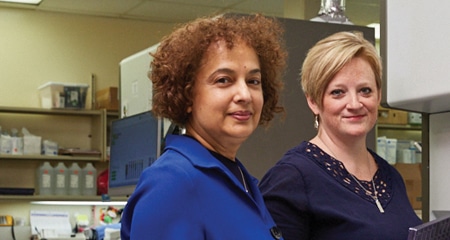August 2023—Anatomic pathology laboratories—the pressures, the promise of technology to alleviate them, and the seemingly unprecedented rates of change. CAP TODAY publisher Bob McGonnagle gathered pathologists and company representatives online on June 21 to talk about it all. From pathologist coverage to IT, from tumor boards to questions job candidates in pathology should ask, here’s what they told us.
Read More »‘Doing more for less and with less’: Turning to IT
February 2023—As this year’s guide to anatomic pathology computer systems was taking shape, CAP TODAY publisher Bob McGonnagle met online with representatives of five companies and with John Sinard, MD, PhD, of Yale University School of Medicine. They talked about the cloud, CPT codes, training of pathology informaticians, and artificial intelligence, for which the time frame in pathology is far longer than it’s been portrayed, in Dr. Sinard’s view. “It will start to impact the careers of some of our trainees, but it’s probably a 10- to 20-year time frame before it plays a major role,” he said. The view of Joe Nollar of Xifin: “Speculation that AI will someday replace pathologists is completely overblown,” though it will help to triage cases and mitigate risk. Their full conversation, which took place Dec. 20, 2022, follows.
Read More »Pathology hospitalists in place at UMich
April 2022—Asked why he robs only trains, Richard Farnsworth’s Gentleman Bandit in The Grey Fox answers with a truth universally acknowledged: “A professional always specializes.” In line with that conviction, there’s little debate on the value of specialization in medicine—or, as it has evolved more recently, the extraordinary value of subspecialization in anatomic pathology. Many consider subspecialist signout to be the gold standard of review and diagnosis in pathology. Because they are dealing with a small number of pathologies, “the care that subspecialists can provide is phenomenal,” says L. Priya Kunju, MD, director of surgical pathology at University of Michigan Health. But in hospital practice at academic institutions like the University of Michigan, when it comes to time-sensitive frozen sections, subspecialization can have a downside. The need to return a diagnosis of a frozen section within 20 minutes while a surgery is in progress may require that an array of different subspecialists be close at hand, near the operating room.
Read More »A look ahead at AI-based assistance in anatomic pathology
February 2022—In a survey of the international pathology community on the integration of artificial intelligence into diagnostic pathology practice, 80 percent of the 487 respondents predicted integration within the next five or 10 years.
Read More »The rush to deliver integrated reporting in pathology
February 2022—Oracle’s purchase of Cerner, cloud computing, and integrated reporting were up for discussion when CAP TODAY publisher Bob McGonnagle convened a virtual roundtable Jan. 6 on anatomic pathology computer systems. Hematopathologist Monica E. de Baca, MD, said on the call she was encouraged by what she heard about integrated reporting from the AP LIS vendor reps on the call. But she said: “We should also be thinking about what is next; we don’t want to be talking about things 10 years after they were needed.” She and seven others answered McGonnagle’s questions, among them: Are the resources in pathology adequate to make progress toward and enable the necessary IT outcomes?
Read More »AP lab maps its cyberattack recovery
August 2021—The downtime manual that the anatomic pathology laboratory at the University of Vermont Medical Center maintained in 2020 was never intended to be used for dealing with a cyberattack. In fact, it wasn’t actually a manual. It was a laboratory-wide policy essentially consisting of one instruction to be used in the event of a power failure or short-term IT disruption or other emergency: “Bring everything to a halt.” In anatomic pathology, “Our downtime protocol was: You stop in your tracks,” says dermatopathologist Anne M. Stowman, MD. “For the urgent/emergent specimens, you get out your paper logs, you do paper recording of the cases coming in, and you handwrite your cassettes, your descriptions, your slides.” That would be a bit slower and less efficient, but it would work for brief, temporary outages and disruptions. But the cyberattack that UVMMC experienced in October 2020, cutting off the labs’ access to the medical center’s information technology systems and disabling operations for more than three weeks, was an abrupt wake-up call.
Read More »CAP TODAY Roundtable: AP computer system— ‘Look at value versus cost’
February 2021—What is the one most important thing to look for in an anatomic pathology computer system? That is one of several questions CAP TODAY publisher Bob McGonnagle put to five people in a Dec. 14 call on the AP LIS and more—surgical pathology volumes amid COVID-19, data integration, practice consolidation.
Read More »At UW, anatomic pathology rotation moves online
July—When COVID-19 set in, much of residency education in the U.S. moved online. At the University of Washington School of Medicine, anatomic pathology faculty took online learning a step further by creating a virtual two-week anatomic pathology rotation for medical students. The faculty is aiming for a four-week virtual rotation inclusive of more laboratory medicine, to be used even after the pandemic has passed.
Read More »AP labs diving deeper into automation
September 2019—Talk to a few anatomic pathology laboratory directors about automation, and you may hear references to early network television, when automation’s downsides were mined for comedy. In one interview with CAP TODAY, a lab director drew parallels between potential backups in the automated AP lab and Lucy and Ethel’s travails keeping pace with a chocolate factory conveyor belt. There is strong agreement, to state it in 1960s TV terms, that even for core or centralized AP labs with the necessary volume, the traditional automation options have progressed well beyond the modern Stone Age, but reaching Tomorrowland may require a shift in thinking.
Read More »AP-LIS vendors talk reports, interfaces, protocols
February 2018—Customer demand, cancer protocols, and consolidation of pathology practices are some of what CAP TODAY asked about when it spoke in January with four anatomic pathology computer system companies. Their AP systems and those of 17 other companies are profiled in the anatomic pathology computer systems interactive product guide. “It’s a really good time for our market right now,” says Joe Nollar of Xifin, “and systems providers need to be creative in helping their clients get the solutions they need to be scalable, competitive, and profitable.” Here is more of what they told writer Anne Ford.
Read More »Book review: ‘Resource of choice’ for quality management in AP
February 2017—“Quality management” is the practice of continually evaluating, identifying, and improving the diagnostic process. It refers not only to retrospective action taken after mistakes have been made but also to evaluating near misses and opportunities for improvement in every facet of practice.
Read More »‘Brave’ new book—AP quality management for everyone
January 2017—What does it take to produce and edit the first book on AP quality management that the CAP has published in more than a decade? A diverse network of experts, a commitment to comprehensive quality assurance, and, says co-editor Qihui “Jim” Zhai, MD, a bit of bravery.
Read More »With AP systems, sharing (data) is caring—and a trend
February 2014—Call it the “Huh?” heard ’round the world: Just last month, Google spent $3.2 billion to acquire Nest Labs, a manufacturer of thermostats and smoke and carbon monoxide detectors. As Brandon Willis, director of technology at Pathagility, puts it, “Who knew Google would want a company that makes home thermostats?”
Read More » CAP TODAY Pathology/Laboratory Medicine/Laboratory Management
CAP TODAY Pathology/Laboratory Medicine/Laboratory Management



